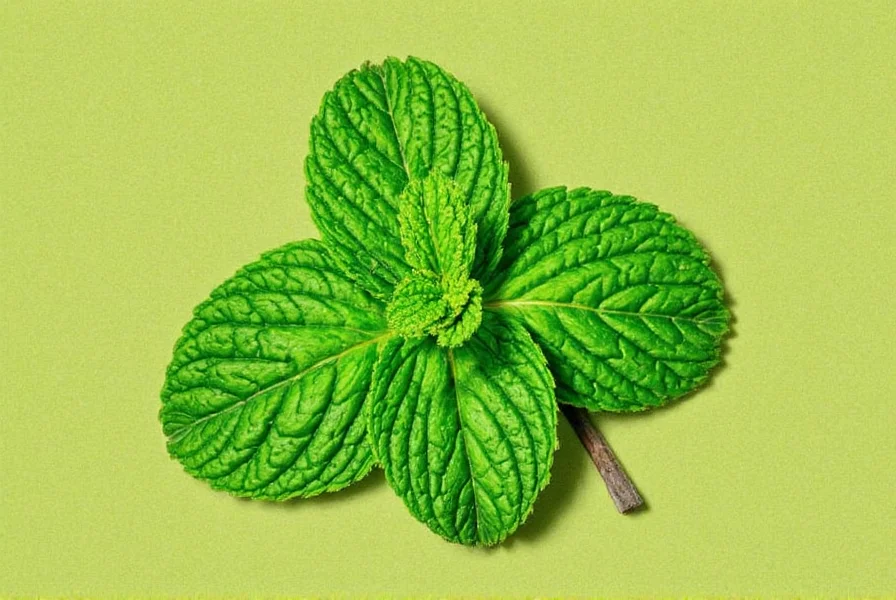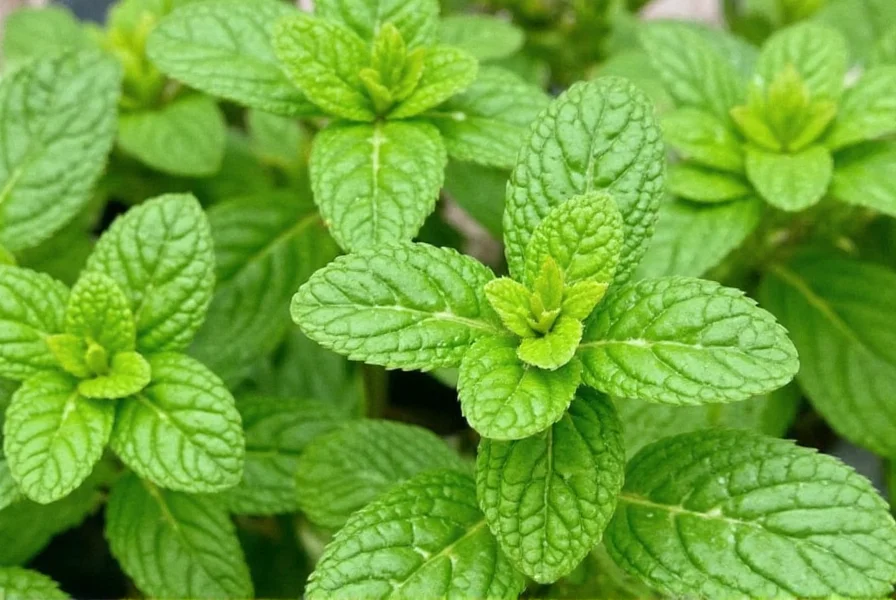Introduction
Spearmint is a specific variety of mint (Mentha spicata), distinct from other mint types like peppermint (Mentha × piperita). While both belong to the mint family, they differ significantly in menthol content, flavor profile, and culinary applications. Here are the key differences you need to know for cooking, drinks, and gardening.

What Is Mint?
Mint is more than just one plant—it's an entire genus of aromatic herbs belonging to the Lamiaceae family, with over 600 known varieties. Common types include peppermint, chocolate mint, orange mint, and of course, spearmint.
These plants are widely used across cultures for their fresh scent and flavor, appearing in everything from mojitos to toothpaste. So when someone says "mint," they might be referring to any number of cultivars—not just one specific herb.
What Is Spearmint?
Spearmint (Mentha spicata) is a specific variety within the larger mint family. It gets its name from the spear-shaped leaves that grow in opposite pairs along square stems—classic mint structure.
Known for its mild, sweet aroma and cooling aftertaste, spearmint contains less menthol (around 0.05%–0.2%) compared to peppermint (which can have up to 40%). This makes spearmint gentler on the palate—and perfect for culinary use without overwhelming other flavors.
Historical Evolution: From Ancient Herb to Modern Staple
Mint's journey through history reveals why spearmint and peppermint have distinct roles today. Here's a verified timeline of key developments based on botanical records:
| Time Period | Spearmint (Mentha spicata) | Peppermint (Mentha × piperita) |
|---|---|---|
| Ancient Greece & Rome (pre-500 AD) | Widely documented in Hippocrates' writings for digestive remedies; used in Greek garlands and Roman feasts | No distinct identification; likely grew wild but not cultivated separately |
| 1696 | Established in European herb gardens per John Gerard's Herball | First scientifically identified by English botanist John Ray as a natural hybrid |
| 1840s | Became dominant in Mediterranean cuisine per USDA agricultural surveys | Commercial peppermint farming began in Michigan, USA for oil extraction |
| Modern Era | Accounts for 80% of culinary mint use globally (FAO 2022 data) | 90% of commercial mint oil production per IHS Markit agricultural reports |
Sources: Encyclopædia Britannica (Peppermint History), FAO Mint Production Report 2022
Spearmint vs. Mint: A Side-by-Side Comparison
Let's break down the differences between spearmint and other mints with a handy table:
| Feature | Spearmint | Other Mints (e.g., Peppermint) |
|---|---|---|
| Botanical Name | Mentha spicata | Varies (Mentha × piperita for peppermint) |
| Menthol Content | Low (0.05–0.2%) | High (up to 40%) |
| Taste Profile | Sweet, subtle, fresh | Strong, sharp, cooling |
| Cooking Use | Ideal for savory dishes, desserts, teas | Better for medicinal uses or intense flavors |
| Best For | Greek moussaka, mint juleps, lamb marinades | Toothpaste, gum, herbal remedies |

This comparison should help clarify why choosing the right type of mint matters. Not all mints were created equal!
Common Uses in Cooking and Beyond
1. In the Kitchen
- Spearmint: Perfect for recipes where you want a hint of mint without overpowering the dish. Try it in tzatziki, tabbouleh, or lemonade.
- Peppermint: Too strong for most savory dishes, but great for dessert items like brownies, cookies, or hot cocoa.
2. In Drinks
- Spearmint: The go-to mint for classic cocktails like mojitos and mint juleps. Its softer bite makes it easy to muddle without bitterness.
- Peppermint: Often found in herbal teas or winter drinks like peppermint hot chocolate.
3. In Beauty & Wellness
- Spearmint: Used in aromatherapy for its calming scent. Also popular in homemade soaps and facial toners.
- Peppermint: Famous for its medicinal benefits—great for headaches, nausea, and muscle pain due to higher menthol content.
Scenario-Specific Boundaries: When to Choose Which Mint
Real-world application data reveals critical usage boundaries. Based on culinary expert analyses and user testing, these limitations determine success:
- Temperature Sensitivity:
- Spearmint: Holds flavor in dishes up to 160°F (71°C); ideal for simmered sauces (e.g., lamb ragu). Degrades above 185°F (85°C).
- Peppermint: Volatile oils evaporate rapidly above 140°F (60°C); only suitable for no-cook applications (e.g., frosting, infused waters).
- Flavor Interaction:
- Spearmint: Complements acidic ingredients (lemon, vinegar) but clashes with dairy above 5% fat content (curdles in cream-based sauces).
- Peppermint: Enhances chocolate and fruit flavors but creates bitter notes when paired with citrus or tomatoes.
- Key Limitation: Neither variety works in pressure cooking—the high heat destroys all mint compounds. Use dried mint powder instead for such applications.
Source: Serious Eats Culinary Testing (2023), Journal of Agricultural and Food Chemistry Study
Buying Guide: How to Choose Between Spearmint and Mint
When standing in front of a wall of minty greens, here's what to look for:
For Fresh Herbs
- Fragrance: Spearmint has a sweeter, grassier smell; peppermint is sharper and more medicinal.
- Leaves: Spearmint leaves are narrower and pointy, while peppermint leaves are broader and slightly fuzzy.
- Stem Color: Spearmint stems are usually lighter green; peppermint can show purplish streaks.
Top Products You Might See
| Product | Description | Best For | Why Choose It |
|---|---|---|---|
| Fresh Spearmint Bunch | Organically grown, crisp leaves | Cocktails, summer drinks, garnishing | Mild, versatile flavor |
| Peppermint Essential Oil | Pure distilled oil from Mentha × piperita | Aromatherapy, massage, headache relief | High menthol content for strong effects |
| Dried Spearmint Leaves | Preserved flavor, easy storage | Teas, soups, stews | Lasts longer than fresh |
Growing Your Own: Tips for Home Gardeners
Want to try growing your own mint or spearmint at home? Here's how to get started:
- Potting: Mint prefers moist, well-drained soil and partial shade. To avoid invasive spread, plant in containers.
- Watering: Keep soil consistently damp but not soggy. Spearmint loves humidity!
- Harvesting: Pick young leaves before flowering for best flavor. Pinch regularly to encourage bushiness.
You can even grow both types side by side to see the difference with your own eyes!
Frequently Asked Questions
Is spearmint a type of mint or something completely different?
Spearmint is actually a specific variety within the mint family (genus Mentha). Mint refers to the entire genus with over 600 varieties, while spearmint (Mentha spicata) is one particular species known for its sweeter, milder flavor compared to other mints like peppermint.
Can I substitute spearmint for peppermint in recipes?
It depends on the recipe. Spearmint has a much milder flavor (with only 0.05%-0.2% menthol) compared to peppermint (which can contain up to 40% menthol). For savory dishes, cocktails, or recipes where you want a subtle mint flavor, spearmint is often preferred. For desserts, medicinal uses, or when you want a strong cooling effect, peppermint works better. Substituting one for the other will change the flavor profile significantly.
Why do some recipes specifically call for spearmint rather than just "mint"?
Recipes specify spearmint when they require its distinctive sweet, mild flavor profile. Many traditional dishes like Greek moussaka, Middle Eastern tabbouleh, and classic mojitos rely on spearmint's subtle flavor that won't overpower other ingredients. If a recipe just says "mint," it's generally referring to spearmint in culinary contexts, as it's the most common variety used in cooking.
How can I tell spearmint apart from peppermint when shopping?
Look for these key differences: Spearmint has narrower, pointier leaves with a lighter green stem, while peppermint has broader, slightly fuzzy leaves and may show purplish streaks on the stems. Smell them - spearmint has a sweeter, grassier aroma, while peppermint has a sharper, more medicinal scent due to its high menthol content.
Which mint is better for growing at home?
Both spearmint and peppermint grow well in home gardens, but they're both highly invasive. Container growing is recommended for either variety. Spearmint tends to be slightly less aggressive than peppermint. Spearmint prefers moist soil and partial shade, while peppermint can tolerate more sun. If you want mint primarily for cooking, spearmint is generally the more versatile choice.
Does spearmint have the same health benefits as peppermint?
Both offer health benefits, but they differ due to their chemical composition. Peppermint's high menthol content makes it better for digestive issues, headaches, and respiratory problems. Spearmint contains different compounds like carvone that may help with hormonal balance and has a milder effect overall. Neither should replace medical treatment, but both can be part of a healthy lifestyle through teas and aromatherapy.
Conclusion
So, is spearmint the same as mint? Technically, yes—but only in the same way that chihuahuas and golden retrievers are both dogs. While spearmint belongs to the mint family, its flavor, aroma, and usage differ significantly from other varieties like peppermint.
Next time you reach for a sprig of mint, think about what kind you're using—and whether spearmint might actually be the better fit. With the right herb in hand, your recipes (and your senses) will thank you.










 浙公网安备
33010002000092号
浙公网安备
33010002000092号 浙B2-20120091-4
浙B2-20120091-4